Novel tacrine-tryptophan hybrids: Multi-target directed ligands as potential treatment for Alzheimer's disease.
Chalupova, K., Korabecny, J., Bartolini, M., Monti, B., Lamba, D., Caliandro, R., Pesaresi, A., Brazzolotto, X., Gastellier, A.J., Nachon, F., Pejchal, J., Jarosova, M., Hepnarova, V., Jun, D., Hrabinova, M., Dolezal, R., Zdarova Karasova, J., Mzik, M., Kristofikova, Z., Misik, J., Muckova, L., Jost, P., Soukup, O., Benkova, M., Setnicka, V., Habartova, L., Chvojkova, M., Kleteckova, L., Vales, K., Mezeiova, E., Uliassi, E., Valis, M., Nepovimova, E., Bolognesi, M.L., Kuca, K.(2019) Eur J Med Chem 168: 491-514
- PubMed: 30851693
- DOI: https://doi.org/10.1016/j.ejmech.2019.02.021
- Primary Citation of Related Structures:
5NUU, 6I0B, 6I0C - PubMed Abstract:
A combination of tacrine and tryptophan led to the development of a new family of heterodimers as multi-target agents with potential to treat Alzheimer's disease. Based on the in?vitro biological profile, compound S-K1035 was found to be the most potent inhibitor of human acetylcholinesterase (hAChE) and human butyrylcholinesterase (hBChE), demonstrating balanced IC 50 values of 6.3 and 9.1?nM, respectively. For all the tacrine-tryptophan heterodimers, favorable inhibitory effect on hAChE as well as on hBChE was coined to the optimal spacer length ranging from five to eight carbon atoms between these two pharmacophores. S-K1035 also showed good ability to inhibit A¦Â 42 self-aggregation (58.6?¡À?5.1% at 50?¦̀M) as well as hAChE-induced A¦Â 40 aggregation (48.3?¡À?6.3% at 100?¦̀M). The X-ray crystallographic analysis of TcAChE in complex with S-K1035 pinpointed the utility of the hybridization strategy applied and the structures determined with the two K1035 enantiomers in complex with hBChE could explain the higher inhibition potency of S-K1035. Other in?vitro evaluations predicted the ability of S-K1035 to cross blood-brain barrier and to exert a moderate inhibition potency against neuronal nitric oxide synthase. Based on the initial promising biochemical data and a safer in?vivo toxicity compared to tacrine, S-K1035 was administered to scopolamine-treated rats being able to dose-dependently revert amnesia.
Organizational Affiliation:
National Institute of Mental Health, Topolova 748, 250 67, Klecany, Czech Republic; Department of Chemistry, University of Hradec Kralove, Rokitanskeho 62, 500 03, Hradec Kralove, Czech Republic.

















